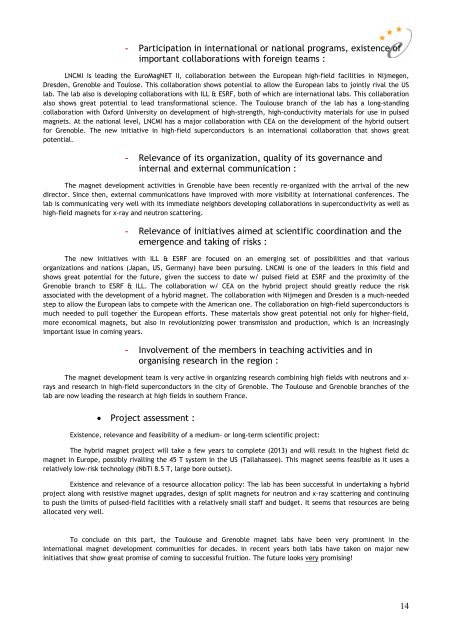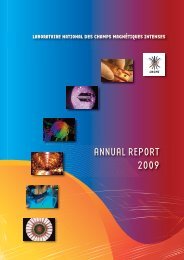Laboratoire National des Champs Magnétiques Pulsés CNRS – INSA
Laboratoire National des Champs Magnétiques Pulsés CNRS – INSA
Laboratoire National des Champs Magnétiques Pulsés CNRS – INSA
Create successful ePaper yourself
Turn your PDF publications into a flip-book with our unique Google optimized e-Paper software.
- Participation in international or national programs, existence of<br />
important collaborations with foreign teams :<br />
LNCMI is leading the EuroMagNET II, collaboration between the European high-field facilities in Nijmegen,<br />
Dresden, Grenoble and Toulose. This collaboration shows potential to allow the European labs to jointly rival the US<br />
lab. The lab also is developing collaborations with ILL & ESRF, both of which are international labs. This collaboration<br />
also shows great potential to lead transformational science. The Toulouse branch of the lab has a long-standing<br />
collaboration with Oxford University on development of high-strength, high-conductivity materials for use in pulsed<br />
magnets. At the national level, LNCMI has a major collaboration with CEA on the development of the hybrid outsert<br />
for Grenoble. The new initiative in high-field superconductors is an international collaboration that shows great<br />
potential.<br />
- Relevance of its organization, quality of its governance and<br />
internal and external communication :<br />
The magnet development activities in Grenoble have been recently re-organized with the arrival of the new<br />
director. Since then, external communications have improved with more visibility at international conferences. The<br />
lab is communicating very well with its immediate neighbors developing collaborations in superconductivity as well as<br />
high-field magnets for x-ray and neutron scattering.<br />
- Relevance of initiatives aimed at scientific coordination and the<br />
emergence and taking of risks :<br />
The new initiatives with ILL & ESRF are focused on an emerging set of possibilities and that various<br />
organizations and nations (Japan, US, Germany) have been pursuing. LNCMI is one of the leaders in this field and<br />
shows great potential for the future, given the success to date w/ pulsed field at ESRF and the proximity of the<br />
Grenoble branch to ESRF & ILL. The collaboration w/ CEA on the hybrid project should greatly reduce the risk<br />
associated with the development of a hybrid magnet. The collaboration with Nijmegen and Dresden is a much-needed<br />
step to allow the European labs to compete with the American one. The collaboration on high-field superconductors is<br />
much needed to pull together the European efforts. These materials show great potential not only for higher-field,<br />
more economical magnets, but also in revolutionizing power transmission and production, which is an increasingly<br />
important issue in coming years.<br />
- Involvement of the members in teaching activities and in<br />
organising research in the region :<br />
The magnet development team is very active in organizing research combining high fields with neutrons and xrays<br />
and research in high-field superconductors in the city of Grenoble. The Toulouse and Grenoble branches of the<br />
lab are now leading the research at high fields in southern France.<br />
� Project assessment :<br />
Existence, relevance and feasibility of a medium- or long-term scientific project:<br />
The hybrid magnet project will take a few years to complete (2013) and will result in the highest field dc<br />
magnet in Europe, possibly rivalling the 45 T system in the US (Tallahassee). This magnet seems feasible as it uses a<br />
relatively low-risk technology (NbTi 8.5 T, large bore outset).<br />
Existence and relevance of a resource allocation policy: The lab has been successful in undertaking a hybrid<br />
project along with resistive magnet upgra<strong>des</strong>, <strong>des</strong>ign of split magnets for neutron and x-ray scattering and continuing<br />
to push the limits of pulsed-field facilities with a relatively small staff and budget. It seems that resources are being<br />
allocated very well.<br />
To conclude on this part, the Toulouse and Grenoble magnet labs have been very prominent in the<br />
international magnet development communities for deca<strong>des</strong>. In recent years both labs have taken on major new<br />
initiatives that show great promise of coming to successful fruition. The future looks very promising!<br />
14







